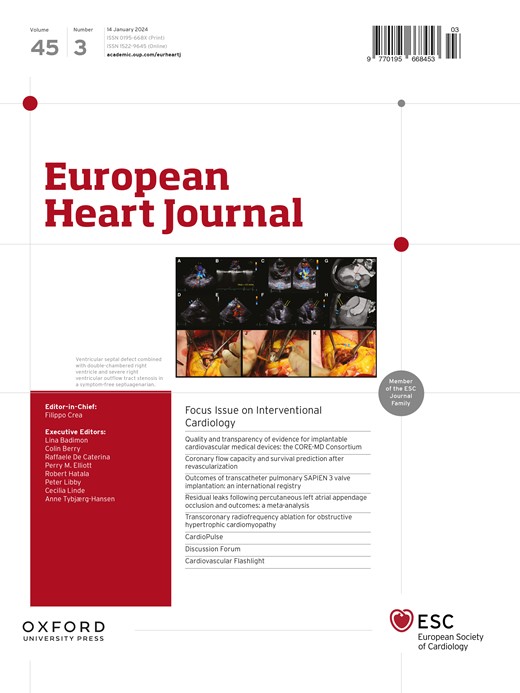Genetic variants of glucose-dependent insulinotropic polypeptide (GIP) signalling as proxy for body weight reduction and cardiovascular risk.
IF 35.6
1区 医学
Q1 CARDIAC & CARDIOVASCULAR SYSTEMS
引用次数: 0
Abstract
BACKGROUND AND AIMS Anti-obesity therapies co-targeting the glucose-dependent insulinotropic polypeptide (GIP) receptor achieve greater weight loss compared with glucagon-like peptide-1 receptor agonists. However, the implications for cardiovascular risk reduction and the mechanisms involved remain unclear. This study aimed to (i) investigate whether genetically proxied body weight reduction via the GIP receptor pathway lowers cardiovascular disease risk and (ii) compare the effect to polygenic weight reduction, excluding GIP-related genes, to assess if the observed benefits are attributable to weight loss per se or involve additional GIP-related effects. METHODS Genetic scores were constructed using four variants in GIP-related genes associated with lower body mass index (BMI) and 31 variants linked to lower BMI in general. Observational and one-sample Mendelian randomization (MR) analyses were performed in 408 056 individuals from the UK Biobank and two-sample MR analyses using summary statistics from 419 821 individuals in FinnGen. RESULTS In one-sample MR analyses, 1 kg/m² lower BMI via the GIP/GIPR score was associated with 29% lower risk of major adverse cardiovascular events (MACE) (P = .0002) and 43% lower risk of heart failure (P = 5 × 10⁻⁵). Corresponding lower risks with the polygenic BMI score were 3% (P = .002) and 13% (P < 1 × 10-300). Two-sample MR analyses showed similar results. Of the reduced risk via the GIP/GIPR score, BMI and glycated haemoglobin (HbA1c) mediated 13% and 22% of the lower risk of MACE and 16% and 17% of the lower risk of heart failure (all P ≤ 7 × 10-5). CONCLUSIONS Genetic proxies for body weight reduction via GIP receptor targeting reduces the risk of MACE and heart failure, mediated partly through lower BMI and partly through lower HbA1c.葡萄糖依赖性胰岛素多肽(GIP)信号的遗传变异作为体重减轻和心血管风险的代理
背景和目的与胰高血糖素样肽-1受体激动剂相比,共同靶向葡萄糖依赖性胰岛素性多肽(GIP)受体的抗肥胖治疗可实现更大的体重减轻。然而,对降低心血管风险的影响及其机制尚不清楚。本研究旨在(i)调查通过GIP受体途径的遗传介导的体重减轻是否会降低心血管疾病的风险;(ii)比较不包括GIP相关基因的多基因体重减轻的效果,以评估观察到的益处是归因于体重减轻本身还是涉及额外的GIP相关效应。方法利用与较低体重指数(BMI)相关的4个gip相关基因变异和31个与一般较低BMI相关的变异构建遗传评分。对来自英国生物银行的408056名个体进行观察性和单样本孟德尔随机化(MR)分析,并对来自芬兰的419821名个体进行双样本MR分析。结果在单样本MR分析中,通过GIP/GIPR评分降低1 kg/m²的BMI与主要心血管不良事件(MACE)风险降低29% (P = 0.0002)和心力衰竭风险降低43% (P = 5 × 10⁻- 5)相关。多基因BMI评分相应的低风险分别为3% (P = 0.002)和13% (P < 1 × 10-300)。两个样本的MR分析显示了类似的结果。在通过GIP/GIPR评分降低的风险中,BMI和糖化血红蛋白(HbA1c)介导MACE风险降低13%和22%,心力衰竭风险降低16%和17%(所有P≤7 × 10-5)。结论:通过GIP受体靶向降低体重的遗传代理降低了MACE和心力衰竭的风险,部分通过降低BMI和降低HbA1c介导。
本文章由计算机程序翻译,如有差异,请以英文原文为准。
求助全文
约1分钟内获得全文
求助全文
来源期刊

European Heart Journal
医学-心血管系统
CiteScore
39.30
自引率
6.90%
发文量
3942
审稿时长
1 months
期刊介绍:
The European Heart Journal is a renowned international journal that focuses on cardiovascular medicine. It is published weekly and is the official journal of the European Society of Cardiology. This peer-reviewed journal is committed to publishing high-quality clinical and scientific material pertaining to all aspects of cardiovascular medicine. It covers a diverse range of topics including research findings, technical evaluations, and reviews. Moreover, the journal serves as a platform for the exchange of information and discussions on various aspects of cardiovascular medicine, including educational matters.
In addition to original papers on cardiovascular medicine and surgery, the European Heart Journal also presents reviews, clinical perspectives, ESC Guidelines, and editorial articles that highlight recent advancements in cardiology. Additionally, the journal actively encourages readers to share their thoughts and opinions through correspondence.
 求助内容:
求助内容: 应助结果提醒方式:
应助结果提醒方式:


